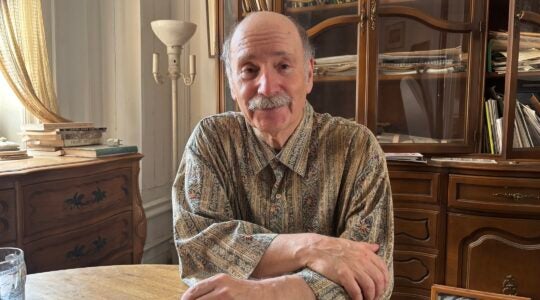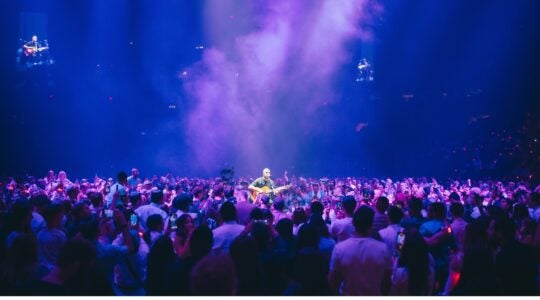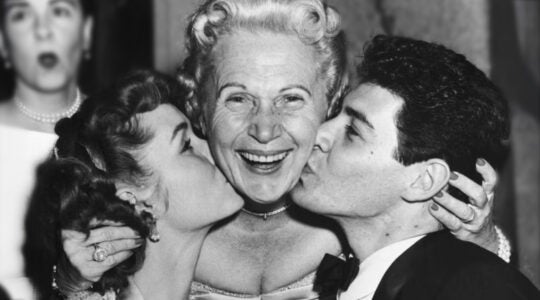‘Judaism is such an intellectual religion that people sometimes turn their backs on their bodies,” said modern dancer Anna Schon, who is Modern Orthodox. “It’s a religion of action, not just learning.”
Schon is a rarity in the dance world — an observant Jew in an acclaimed modern dance troupe, Reggie Wilson Fist & Heel, which is deeply inspired by African movement. And when she takes the stage next week at modern dance’s summer Holy Land, the Jacob’s Pillow Dance Festival in the Berkshires, she’ll be in “action” in Wilson’s piece “Moses(es).” Inspired by a Zora Neal Hurston work, the modern/African dance fusion features music by Louis Armstrong, the Klezmatics and African-American spirituals, and is based on Wilson’s “cultural explorations in Israel, Egypt and Turkey.”
The coming together of religious yearning and the world of movement is uplifting to Schon, who lives on the Upper West Side. “The African-American spirituals particularly inspire me,” she told The Jewish Week in a recent interview. “There’s a real connection to God. God is not something that’s far away and unreachable. The spirituals bring God down to the planet.”
As unique as her personal story is, Schon’s interest in African dance and African-American spirituals mirrors a cultural oddity that rings true to anyone who has logged hours sweating through rib-shaking and foot-stomping African dance classes at studios around New York — in which, for some reason, Jews seem over-represented.
Jews and blacks have long had deep cultural ties — the Gershwins drew heavily on the African-American experience, Benny Goodman’s 1930s jazz quartet with Teddy Wilson and Lionel Hampton was the country’s first integrated band, and Jewish pop musicians from Bob Dylan to the Beastie Boys have been strongly inspired by the blues and hip-hop. In the world of modern dance, Alvin Ailey’s classic work about the African-American experience, “Revelations,” set to African-American spirituals, had its premiere at the 92nd Street Y, one of the country’s most influential venues for modern dance.
But the black-Jewish connection in African dance is something that has flown under the cultural radar.
Yael Shacham’s African journey began with a musical childhood. Shacham is founder, with Lara Gonzalez, of Marafanyi Drum Dance & Song, an educational, therapeutic and performance group for all ages and populations based in North Adams, Mass.
Her attraction to world music came from feeling like an outsider when she immigrated to the United States from Israel when she was 7 years old. “We never talked about our Judaism making us open and creative but maybe so,” she said.
As a young adult, Shacham chose to focus her studies on African music. “I really loved West African,” she said. “It’s not simple; it’s difficult. So many layers are going on but at the same time it’s accessible.”
Her feelings of being different than others in her suburban New Jersey town fostered a kinship with the African American community. “We have all been persecuted. We have all had that struggle,” she said. “Somewhere there’s this understanding between us. We have all been persecuted in different places on the planet, so I feel that’s the connection that’s very deep and very subtle.”
That connection is also present for Rebecca Missel, director of institutional grants at the Metropolitan Council on Jewish Poverty, who has been a student of African dance for seven years.
“I have always felt some sort of affinity for myself with the black community,” she said, “and dance was an extremely accessible way to branch into that community.”
Missel said she is attracted to the strong feminist archetype. “We do warrior dances as women, and I think that very ancient culture that it’s coming from certainly has a very powerful and important role for women.”
African dance moves celebrate an independent female that provides economically and domestically for her family, similar to the role model described in the Woman of Valor hymn, according to Missel. The Lambda dance provides a powerful display of feminism when women mime throwing droopy breasts over their shoulders. It’s a point of African pride when a mother has tangible evidence of having sustained multiple children through years of breast feeding.
“The curvaceous, voluptuous Jewish woman is a stereotype, and that lends itself quite easily to the West African dance environment where having a more voluptuous figure is very respected, honored and praised,” Missel said. “It takes all comers. I really like that about it.”
But while the mind-body connection is crucial to any dance form, movement of ‘the’ body is often absent in Jewish practice.
“It [African dance] gave me the avenue to be committed to my ‘frumkeit’ (observance) because I had a place where I could connect my mind and body,” said Tova who preferred to use her first name to protect the privacy of her rabbi. Tova is an Orthodox woman who sought and received rabbinic permission to attend class because the dances can be construed as “avodah zara” (idol worship). Her rabbi approved dancing strictly as a form of exercise.
The outlet allowed her to express her creative roots while maintaining her frum lifestyle. “Frumkeit was saying I had to be like everyone else,” she said. “I had this very expressive arts way of connecting to God, and I couldn’t cut that part off of myself.”
Many Jewish musicians, moved by the heart-pumping polyrhythms of African music, have also become students of the form.
“A lot of Jews are prone to exploring stimulating musical and artistic outlets and avenues,” said David Freeman, a Brooklyn-based percussionist and educator. “We have the luxury to take advantage of all the joy and the dance and the music that other cultures are willing to share.”
Freeman started drumming in high school. He “fell in love with West African” music and described the rhythms as expressive, exciting and fulfilling. “It’s definitely something magical about the music itself,” he said. “I’ve always been proactively curious, and exploring the world outside of the Jewish world I was raised in was through music.”
African dance is liberating, uplifting, joyous and seductive. But is there a Jewish draw to African-American culture?
Steve Whitfield, a professor of American studies at Brandeis University, discounts the theory that a history of oppression unites the two people. “The circumstances were radically different and merely suffering doesn’t lead anybody necessarily to empathize with the suffering of others,” he said. “There’s got to be something within Jewish culture that stimulates that sense of identification.”
Judaic ideas that could explain empathy for African Americans include themes from the Haggadah and the concept of “tikkun olam” (repairing the world). Jews identify with anybody who was a slave, and making our world a better place demands combating racial injustice, according to Whitfield.
Perhaps there’s a universal attraction to African dance that has nothing to do with Judaism and everything to do with being human.
“People in general are attracted to these rhythms and if you find a lacking in your life and you go into a space and experience something new, it’s going to be really inspiring,” Schon, the professional dancer, said.
“For me I need my entire body to be involved to feel something. So while some people are fine with just singing or speaking, [for me] everything needs to be moving. I could get into a trance place where you just completely forget who you are, where you are, but you know there’s something special coursing through your system, and for me as a Jewish woman I interpret that as “Hashem” (God).
For Julia Peck, a rising junior at Columbia College who completed her second semester of African dance, “Dance is very spiritual; it’s a way of expressing yourself and it’s very universal. Dance binds tons of people together.
It’s a way of expressing yourself,” Peck said, “with out the language of religions getting in the way.”
Reggie Wilson Fist & Heel performs July 9-13 at Jacob’s Pillow Dance Festival 2014 in Becket, Mass. For information, visit jacobspillow.org.
The New York Jewish Week brings you the stories behind the headlines, keeping you connected to Jewish life in New York. Help sustain the reporting you trust by donating today.




